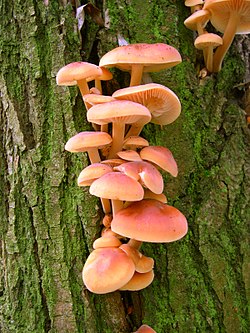| Flammulina | |
|---|---|
 | |
| Flammulina velutipes | |
| Scientific classification | |
| Kingdom: | Fungi |
| Division: | Basidiomycota |
| Class: | Agaricomycetes |
| Order: | Agaricales |
| Family: | Physalacriaceae |
| Genus: | Flammulina P.Karst. (1891) |
| Type species | |
| Flammulina velutipes | |
| Synonyms [1] | |
Collybidium Earle (1909) Contents | |
Flammulina is a genus of fungi in the family Physalacriaceae. The genus, widespread in temperate regions, has been estimated to contain 10 species. [2]





